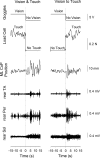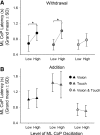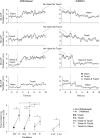Processing time of addition or withdrawal of single or combined balance-stabilizing haptic and visual information
- PMID: 26334013
- PMCID: PMC4686285
- DOI: 10.1152/jn.00618.2015
Processing time of addition or withdrawal of single or combined balance-stabilizing haptic and visual information
Abstract
We investigated the integration time of haptic and visual input and their interaction during stance stabilization. Eleven subjects performed four tandem-stance conditions (60 trials each). Vision, touch, and both vision and touch were added and withdrawn. Furthermore, vision was replaced with touch and vice versa. Body sway, tibialis anterior, and peroneus longus activity were measured. Following addition or withdrawal of vision or touch, an integration time period elapsed before the earliest changes in sway were observed. Thereafter, sway varied exponentially to a new steady-state while reweighting occurred. Latencies of sway changes on sensory addition ranged from 0.6 to 1.5 s across subjects, consistently longer for touch than vision, and were regularly preceded by changes in muscle activity. Addition of vision and touch simultaneously shortened the latencies with respect to vision or touch separately, suggesting cooperation between sensory modalities. Latencies following withdrawal of vision or touch or both simultaneously were shorter than following addition. When vision was replaced with touch or vice versa, adding one modality did not interfere with the effect of withdrawal of the other, suggesting that integration of withdrawal and addition were performed in parallel. The time course of the reweighting process to reach the new steady-state was also shorter on withdrawal than addition. The effects of different sensory inputs on posture stabilization illustrate the operation of a time-consuming, possibly supraspinal process that integrates and fuses modalities for accurate balance control. This study also shows the facilitatory interaction of visual and haptic inputs in integration and reweighting of stance-stabilizing inputs.
Keywords: haptic; sensory integration; sensory reweighting; standing; vision.
Copyright © 2015 the American Physiological Society.
Figures








Similar articles
-
Body sway adaptation to addition but not withdrawal of stabilizing visual information is delayed by a concurrent cognitive task.J Neurophysiol. 2017 Feb 1;117(2):777-785. doi: 10.1152/jn.00725.2016. Epub 2016 Nov 30. J Neurophysiol. 2017. PMID: 27903641 Free PMC article.
-
Balance in Blind Subjects: Cane and Fingertip Touch Induce Similar Extent and Promptness of Stance Stabilization.Front Neurosci. 2018 Sep 11;12:639. doi: 10.3389/fnins.2018.00639. eCollection 2018. Front Neurosci. 2018. PMID: 30254565 Free PMC article.
-
Sensorimotor integration during stance: processing time of active or passive addition or withdrawal of visual or haptic information.Neuroscience. 2012 Jun 14;212:59-76. doi: 10.1016/j.neuroscience.2012.03.044. Epub 2012 Apr 16. Neuroscience. 2012. PMID: 22516013
-
Time-interval for integration of stabilizing haptic and visual information in subjects balancing under static and dynamic conditions.Front Syst Neurosci. 2014 Oct 6;8:190. doi: 10.3389/fnsys.2014.00190. eCollection 2014. Front Syst Neurosci. 2014. PMID: 25339872 Free PMC article. Review.
-
Vision and touch: independent or integrated systems for the perception of texture?Brain Res. 2008 Nov 25;1242:59-72. doi: 10.1016/j.brainres.2008.05.037. Epub 2008 May 22. Brain Res. 2008. PMID: 18585689 Review.
Cited by
-
Body sway adaptation to addition but not withdrawal of stabilizing visual information is delayed by a concurrent cognitive task.J Neurophysiol. 2017 Feb 1;117(2):777-785. doi: 10.1152/jn.00725.2016. Epub 2016 Nov 30. J Neurophysiol. 2017. PMID: 27903641 Free PMC article.
-
Influence of high-definition transcranial direct current stimulation to the parietal cortex on postural control: a single-blind randomized crossover study.Front Hum Neurosci. 2025 May 26;19:1546631. doi: 10.3389/fnhum.2025.1546631. eCollection 2025. Front Hum Neurosci. 2025. PMID: 40491437 Free PMC article.
-
Balance in Blind Subjects: Cane and Fingertip Touch Induce Similar Extent and Promptness of Stance Stabilization.Front Neurosci. 2018 Sep 11;12:639. doi: 10.3389/fnins.2018.00639. eCollection 2018. Front Neurosci. 2018. PMID: 30254565 Free PMC article.
-
Body Sway Increases After Functional Inactivation of the Cerebellar Vermis by cTBS.Cerebellum. 2017 Feb;16(1):1-14. doi: 10.1007/s12311-015-0758-5. Cerebellum. 2017. PMID: 26780373 Free PMC article.
-
Perceptual-motor styles.Exp Brain Res. 2021 May;239(5):1359-1380. doi: 10.1007/s00221-021-06049-0. Epub 2021 Mar 6. Exp Brain Res. 2021. PMID: 33675378 Free PMC article. Review.
References
-
- Azañón E, Longo MR, Soto-Faraco S, Haggard P. The posterior parietal cortex remaps touch into external space. Curr Biol 20: 1304–1309, 2010. - PubMed
-
- Baudry S, Duchateau J. Independent modulation of corticospinal and group I afferents pathways during upright standing. Neuroscience 275: 162–169, 2014. - PubMed
-
- Baudry S, Penzer F, Duchateau J. Vision and proprioception do not influence the excitability of the corticomotoneuronal pathway during upright standing in young and elderly adults. Neuroscience 268: 247–254, 2014. - PubMed
Publication types
MeSH terms
LinkOut - more resources
Full Text Sources
Other Literature Sources
Medical

